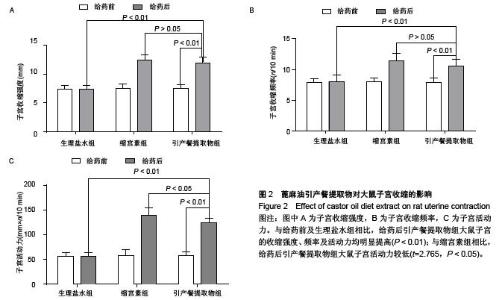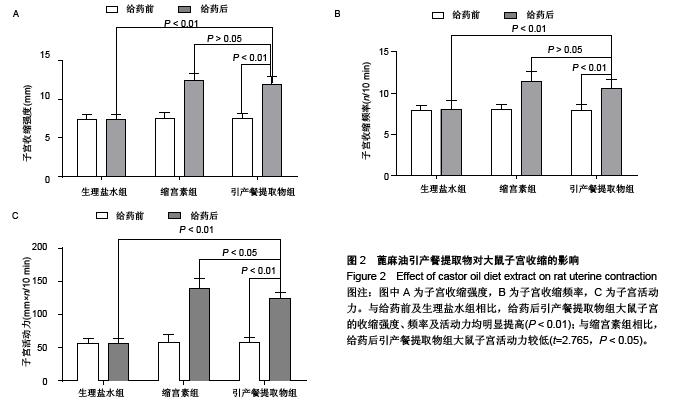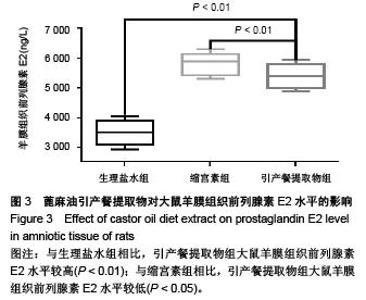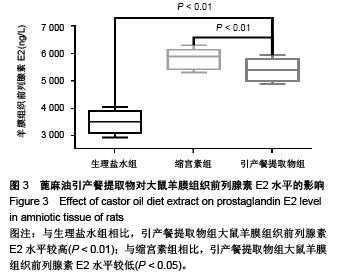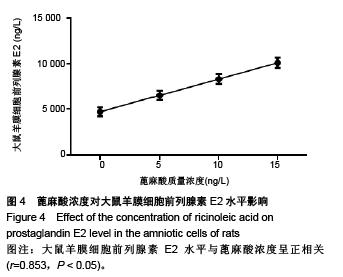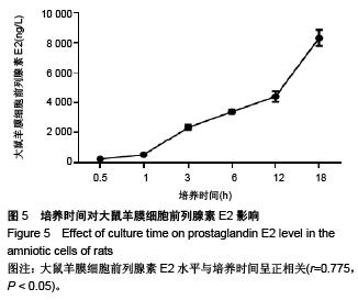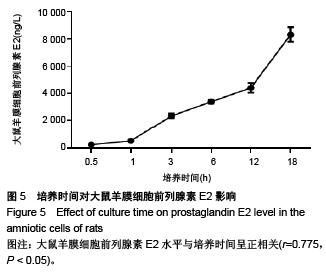Chinese Journal of Tissue Engineering Research ›› 2015, Vol. 19 ›› Issue (49): 8032-8036.doi: 10.3969/j.issn.2095-4344.2015.49.028
Castor oil diet extract affects uterine contraction and the content of prostaglandin E2 in amniotic tissue
Liu Hai-bin
- Department of Obstetrics and Gynecology, Heze Municipal Hospital of Shandong Province, Heze 274000, Shandong Province, China
-
Received:2015-09-13Online:2015-11-30Published:2015-11-30 -
About author:Liu Hai-bin, Master, Attending physician, Department of Obstetrics and Gynecology, Heze Municipal Hospital of Shandong Province, Heze 274000, Shandong Province, China
CLC Number:
Cite this article
Liu Hai-bin. Castor oil diet extract affects uterine contraction and the content of prostaglandin E2 in amniotic tissue [J]. Chinese Journal of Tissue Engineering Research, 2015, 19(49): 8032-8036.
share this article
| [1] 李辉,程蔚.瘢痕子宫孕中期引产相关问题[J].中国实用妇科与产科杂志,2010,26(8):586-589.[2] 钱金凤,黄紫蓉.中期妊娠引产方法评估及选择[J].中国实用妇科与产科杂志,2012,28(9):654-657.[3] 吴玲玲,尹玉竹,古健.普贝生配合缩宫素在足月妊娠引产中的临床应用[J].中国妇产科临床杂志,2008,9(6):431-432,436.[4] 张建平,包琳.正确掌握引产催产方法[J].中国妇产科临床杂志, 2012,28(2):89-93.[5] Saha P, Majumdar S, Pal D, et al. Evaluation of spermicidal activity of MI-saponin A. Reprod Sci. 2010;17(5):454-464. [6] Akbarsha MA, Murugaian P. Aspects of the male reproductive toxicity/male antifertility property of andrographolide in albino rats: effect on the testis and the cauda epididymidal spermatozoa. Phytother Res. 2000;14(6):432-435.[7] 张春霞,祁玉英.蓖麻油餐和清洁灌肠联用进行晚期妊娠引产的临床研究[J].中国保健营养(下旬刊),2012,22(8):2510-2511.[8] 崔春爱,王会弟,高海鹰.蓖麻油引产餐的应用研究[J].中国医药指南,2012(32):369-370.[9] 王福亮.蓖麻油鸡蛋餐与己烯雌酚联用引产疗效的观察[J].内蒙古中医药,2014,33(8):89.[10] 何咏梅.蓖麻油炒鸡蛋用于晚期妊娠引产175例分析[J].医学信息(上旬刊),2010,23(5):1368.[11] 周美华.蓖麻油炒鸡蛋用于妊娠40周后引产50例临床分析[J].工企医刊,2012,25(5):15.[12] 赵玉华.妊娠晚期蓖麻油引产的临床观察[J].中国保健营养(下旬刊),2013,23(1):172.[13] (明)李时珍.本草纲目[M].天津:天津科学技术出版社,2010:370.[14] 孙桂省,翁霞云.不同剂型蓖麻油餐引产效果观察[J].中华妇产科杂志,1994,29(5):299-300.[15] 苏雅拉图,陈宇杰,穆莎茉莉,等.蓖麻籽脱脂提取物对小鼠离体子宫平滑肌的影响[J].中国中医药信息杂志,2014(5):50-52.[16] 高杰.蓖麻油引产餐诱发妊娠大鼠分娩机理的研究[D].北京:中国协和医科大学,1997.[17] 董晓霞,林晓华,王佐.5年剖宫产指征变化分析[J].实用妇产科杂志,2009,25(4):247-249.[18] 陈诚,常青,王琳.剖宫产术后再次妊娠分娩方式的探讨[J].实用妇产科杂志,2012,28(4):278-281.[19] 李源,赵艳晖,孙波,等.剖宫产指征的变迁及其影响因素[J].中国妇幼保健,2007,22(1):30-33.[20] 崔春爱,王会弟,高海鹰.蓖麻油引产餐的应用研究[J].中国医药指南,2012(32):369-370.[21] 尹丽丽,刘海荣.蓖麻油催产餐对产程的影响[J].黑龙江医药, 2014(1)1:170-171.[22] 王福亮.蓖麻油鸡蛋餐与己烯雌酚联用引产疗效的观察[J].内蒙古中医药,2014,33(8):89.[23] 高杰,孙念怙,王凤,等.蓖麻油引产餐对妊娠大鼠分娩的影响[J].中国医学科学院学报,1998,20(5):367-370.[24] 刘丽芬,柴天川,崔文华.引产餐醇提取物对大鼠子宫的影响[J].时珍国医国药,2008,19(4):820-821.[25] 喻佑兰.200例口服复方蓖麻油与单纯蓖麻油引产效果比较[J].护理学杂志,1994,9(3):110.[26] 沙金燕,关海兰,谢红一,等.口服蓖麻油促宫颈成熟及引产[J].第二军医大学学报,1994,15(6):590. [27] 李传香,朱艳梅.蓖麻油引产餐在晚期妊娠计划分娩中的应用[J].中医药研究,2002(1):16. |
| [1] | Chen Ziyang, Pu Rui, Deng Shuang, Yuan Lingyan. Regulatory effect of exosomes on exercise-mediated insulin resistance diseases [J]. Chinese Journal of Tissue Engineering Research, 2021, 25(25): 4089-4094. |
| [2] | Chen Yang, Huang Denggao, Gao Yuanhui, Wang Shunlan, Cao Hui, Zheng Linlin, He Haowei, Luo Siqin, Xiao Jingchuan, Zhang Yingai, Zhang Shufang. Low-intensity pulsed ultrasound promotes the proliferation and adhesion of human adipose-derived mesenchymal stem cells [J]. Chinese Journal of Tissue Engineering Research, 2021, 25(25): 3949-3955. |
| [3] | Yang Junhui, Luo Jinli, Yuan Xiaoping. Effects of human growth hormone on proliferation and osteogenic differentiation of human periodontal ligament stem cells [J]. Chinese Journal of Tissue Engineering Research, 2021, 25(25): 3956-3961. |
| [4] | Sun Jianwei, Yang Xinming, Zhang Ying. Effect of montelukast combined with bone marrow mesenchymal stem cell transplantation on spinal cord injury in rat models [J]. Chinese Journal of Tissue Engineering Research, 2021, 25(25): 3962-3969. |
| [5] | Gao Shan, Huang Dongjing, Hong Haiman, Jia Jingqiao, Meng Fei. Comparison on the curative effect of human placenta-derived mesenchymal stem cells and induced islet-like cells in gestational diabetes mellitus rats [J]. Chinese Journal of Tissue Engineering Research, 2021, 25(25): 3981-3987. |
| [6] | Hao Xiaona, Zhang Yingjie, Li Yuyun, Xu Tao. Bone marrow mesenchymal stem cells overexpressing prolyl oligopeptidase on the repair of liver fibrosis in rat models [J]. Chinese Journal of Tissue Engineering Research, 2021, 25(25): 3988-3993. |
| [7] | Liu Jianyou, Jia Zhongwei, Niu Jiawei, Cao Xinjie, Zhang Dong, Wei Jie. A new method for measuring the anteversion angle of the femoral neck by constructing the three-dimensional digital model of the femur [J]. Chinese Journal of Tissue Engineering Research, 2021, 25(24): 3779-3783. |
| [8] | Meng Lingjie, Qian Hui, Sheng Xiaolei, Lu Jianfeng, Huang Jianping, Qi Liangang, Liu Zongbao. Application of three-dimensional printing technology combined with bone cement in minimally invasive treatment of the collapsed Sanders III type of calcaneal fractures [J]. Chinese Journal of Tissue Engineering Research, 2021, 25(24): 3784-3789. |
| [9] | Qian Xuankun, Huang Hefei, Wu Chengcong, Liu Keting, Ou Hua, Zhang Jinpeng, Ren Jing, Wan Jianshan. Computer-assisted navigation combined with minimally invasive transforaminal lumbar interbody fusion for lumbar spondylolisthesis [J]. Chinese Journal of Tissue Engineering Research, 2021, 25(24): 3790-3795. |
| [10] | Hu Jing, Xiang Yang, Ye Chuan, Han Ziji. Three-dimensional printing assisted screw placement and freehand pedicle screw fixation in the treatment of thoracolumbar fractures: 1-year follow-up [J]. Chinese Journal of Tissue Engineering Research, 2021, 25(24): 3804-3809. |
| [11] | Shu Qihang, Liao Yijia, Xue Jingbo, Yan Yiguo, Wang Cheng. Three-dimensional finite element analysis of a new three-dimensional printed porous fusion cage for cervical vertebra [J]. Chinese Journal of Tissue Engineering Research, 2021, 25(24): 3810-3815. |
| [12] | Wang Yihan, Li Yang, Zhang Ling, Zhang Rui, Xu Ruida, Han Xiaofeng, Cheng Guangqi, Wang Weil. Application of three-dimensional visualization technology for digital orthopedics in the reduction and fixation of intertrochanteric fracture [J]. Chinese Journal of Tissue Engineering Research, 2021, 25(24): 3816-3820. |
| [13] | Sun Maji, Wang Qiuan, Zhang Xingchen, Guo Chong, Yuan Feng, Guo Kaijin. Development and biomechanical analysis of a new anterior cervical pedicle screw fixation system [J]. Chinese Journal of Tissue Engineering Research, 2021, 25(24): 3821-3825. |
| [14] | Lin Wang, Wang Yingying, Guo Weizhong, Yuan Cuihua, Xu Shenggui, Zhang Shenshen, Lin Chengshou. Adopting expanded lateral approach to enhance the mechanical stability and knee function for treating posterolateral column fracture of tibial plateau [J]. Chinese Journal of Tissue Engineering Research, 2021, 25(24): 3826-3827. |
| [15] | Zhu Yun, Chen Yu, Qiu Hao, Liu Dun, Jin Guorong, Chen Shimou, Weng Zheng. Finite element analysis for treatment of osteoporotic femoral fracture with far cortical locking screw [J]. Chinese Journal of Tissue Engineering Research, 2021, 25(24): 3832-3837. |
| Viewed | ||||||
|
Full text |
|
|||||
|
Abstract |
|
|||||


